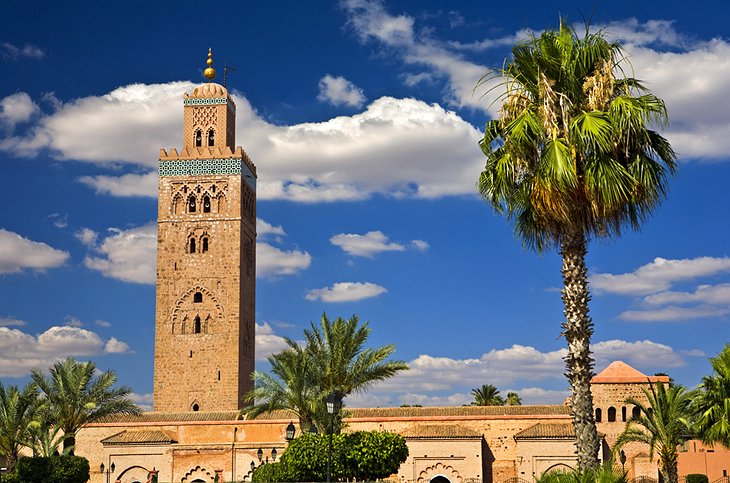Marrakech Sights and Attractions

Djemaa el Fna is the most famous landmark of Marrakech. It is a large open space in the heart of the city where a daily age-old ritual continues to date. As the day proceeds, locals and visitors gather around the square to watch orange juice vendors make way for healers and henna-tattoo artists who in turn melt into the darkness to allow cobra charmers, astrologers, and acrobats to perform. Once they’re done entertaining you, it’s time for the male belly dancers and storytellers to begin their epics. The best way to enjoy the evening’s assorted entertainment is to seat yourself at one of the many cafes that line the square. The grilled meats and cooked salads served at these 100 odd cafes are fresh and delicious!
The Koutoubia is a seventy-meter high tower of the Koutoubia mosque, a landmark that dominates the entire city. Visible for miles, this 12th-century tower is to Marrakech what the Eiffel is to Paris. The tower is laced with intricate tile work and topped with three golden orbs. Many visitors use it to navigate the old city’s maze-like streets.
The Jardin Majorelle – This walled botanical garden, once owned by Yves Saint Laurent, offers a magical stroll right in the middle of the city, yet very far away from it. Walkthrough green foliage and exotic flowers placed artistically around mosaic-lined ponds brimming with lotus flowers and water lilies. Splashes of a distinctive blue color appear in every other corner. There is also a delightful Art Deco-styled building that seems to appear out of nowhere.
Souks of Marrakech. For a first-timer, the souks of Marrakech can be quite overwhelming. There is, however, some sort of order in all this chaos and once you get your bearings, you’re not going to want to leave this labyrinthine maze of streets! The best time to visit is early in the mornings if you’re looking to avoid the rush, but if you’re after good deals then go toward the end of the day. It is quite an experience, with each souk named after the product being sold there, like the dyers’ souk, carpet souk, slipper souk, and so on. This market is famed throughout the world as one of the most exotic places to shop.
The Saadian Tombs. Discovered as recently as the early 20th century, these tombs are the original burial place of the Saadian princes. Lavishly decorated, they give the visitor an insight into the opulence of this period of Moroccan history.
The El Badi and the Bahia Palaces. The El Badi Palace was reputed to be one of the most beautiful palaces in the world. As of today, it stands in its ruins, but enough remains to suggest its former grandeur. Built-in the 16th century, it was later plundered to such an extent that everything movable was removed! The Bahia Palace, on the other hand, built in the late 19th century, was recently restored to its former glory. It stands in stark contrast to the nearby El Badi Palace. Only a part of the palace is open to visitors since the royal family it is still in residence.
After all this sightseeing, be sure to rejuvenate with a steam clean and an orange-flower oil massage at the nearest domed hammaam! Or just relax at the Ménara Garden on a picnic and soak in the magical essence of the “Red City”!
